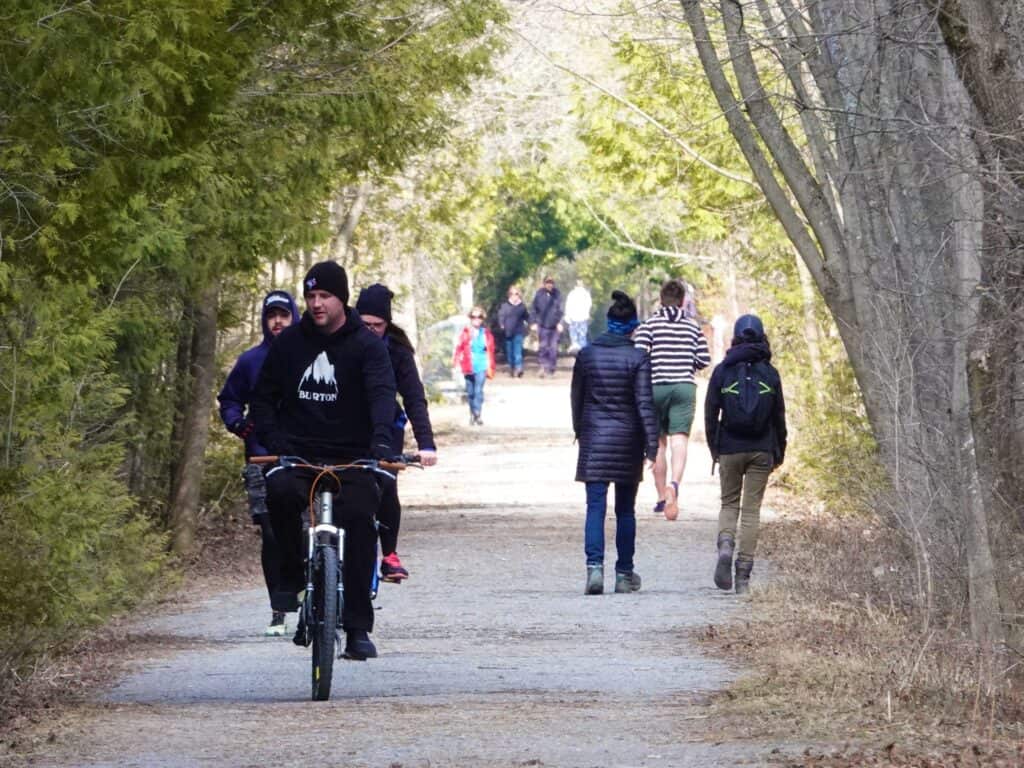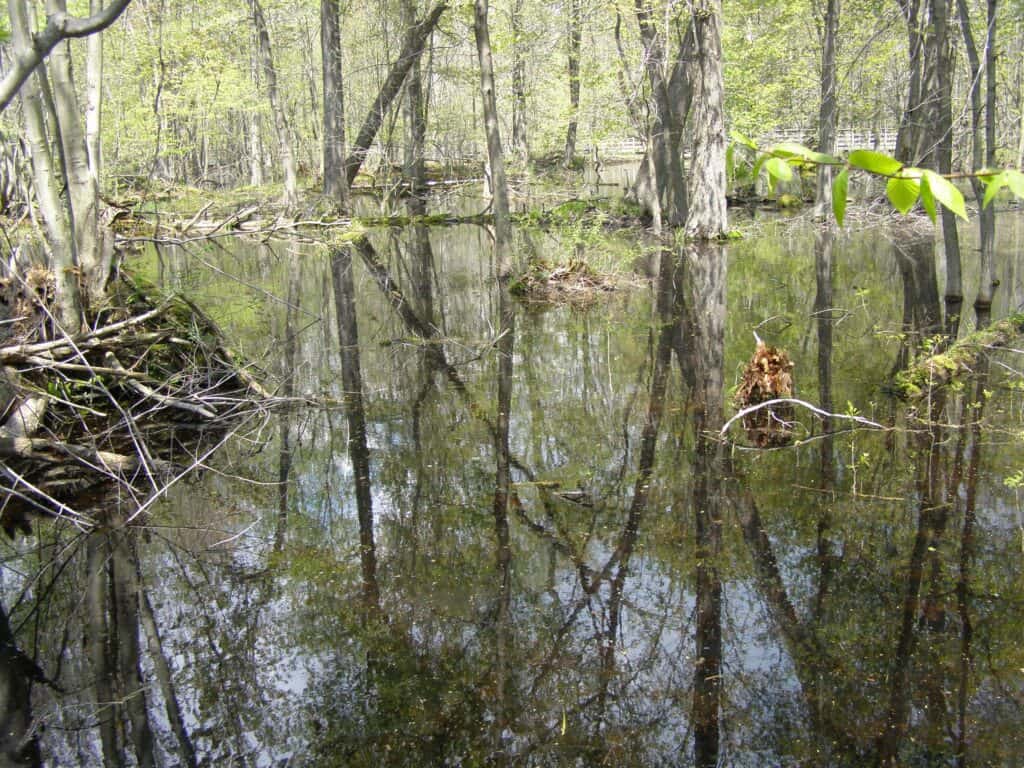Despite recognition of time spent in nature as a pillar of health, protecting greenspace remains an uphill battle
For me, an enduring image of the pandemic will be the unprecedented number of people taking advantage of local rail-trails and parks. Some days, the procession of dog-walkers, cyclists, photographers, joggers, and families has been truly astounding. I don’t think I’ve ever seen so many kids exploring Jackson Creek – dip nets in hand – either. Not only were people enjoying nature, but there was a palpable sense of community and the feeling that we’re all in this pandemic together.

Clearly, the importance of green space to human well-being – especially in times of heightened stress – is one of the many lessons driven home by COVID-19. We’ve also learned just how important it is to respect science and evidence-based decision-making. Jurisdictions that have listened to scientists and medical professionals have seen far less transmission of the virus. Science is also telling us something else: a quickly growing body of research points to the many health benefits of spending time in nature.
More and more doctors are formally prescribing this very thing. The BC Parks Foundation has now launched Canada’s first formal nature-prescribing program known as PaRx, along with the website parkprescriptions.ca. It is free for all licensed health care professionals in British Columbia. One of the architects of the program, Dr. Melissa Lem, wants time spent in nature to be recognized as the fourth pillar of health, along with diet, exercise, and sleep. More and more physicians are recommending nature time for people with depression, anxiety, COVID-related mental health issues, and stress.
Dr. Lem, who is a member of the Canadian Association of Physicians for the Environment, also hopes that this initiative will help Canadians become more active participants in combating climate change as they connect to greenspaces and gain a greater understanding of how quickly the natural world is changing.
Given what we know instinctively and through research about the health benefits of spending time in natural settings, it is all the more disturbing that elected officials, both locally and provincially, don’t seem to have this front of mind.
Inverlea Park
The City has selected five-acre Inverlea Park, located on the north side of Parkhill Road, just east of Water Street, as one of three potential sites for the location of a new north-end fire hall. Approximately two acres or nearly 40% of the park would be taken over by the project. While most everyone supports fire services, recommending Inverlea Park as a potential site almost seems like a joke worthy of April Fool’s Day.
The park has been enjoyed by generations of Peterborough citizens since it was established in 1894 by the trustees of the Nicholls Park Trust, in accordance with Charlotte Nicholls’ will. It was given in good faith to the public to be used for recreation and to enjoy greenspace along the Otonabee River. The park features the longest undeveloped shoreline on the west bank of the Otonabee within walking distance of downtown. This is especially important since the downtown is expected to grow in population density in years to come. It should go without saying that we need to maintain our city parks for the quality of life of Peterborough residents.
Even though Mayor Diane Therrien has stated that council doesn’t appear “to have an appetite” for choosing the park, no one wants to remove it from the menu. Councillors Andrew Beamer and Kim Zippel, who chair the Fire Services Committee, have insisted that Inverlea remain on the table as a potential location for the fire hall.
The 2019 Assessment of Parks and Open Space completed by Basterfield & Associates concludes that Peterborough doesn’t have sufficient greenspace to support our growing community. It emphasizes that the downtown, the north end, and the west end are particularly deficient in this regard. The report is clear that if our current parks aren’t maintained, overall access to public outdoor space will diminish over time. The report calls Inverlea a park of “high visibility and value.”
The city is planning a public consultation for the location of the fire hall. However, as Sylvia Sutherland wrote on November 27 in Peterborough This Week, even considering this location “is a flame that should have been extinguished at birth.” Actions such as this only damages public trust in politicians.
Conservation Authorities under attack
Something infinitely more serious when it comes to protecting greenspace has just happened at Queen’s Park. The Ford government has successfully pulled off a full-frontal attack on Conservation Authorities. On December 8, Ontario passed Bill 229, an omnibus budget bill ostensibly aimed at helping the province bounce back from the ravages of the COVID-19 pandemic.
Schedule 6 of the bill curtails the power of local Conservation Authorities and expands ministerial authority on zoning and other potentially sensitive environmental issues. Because these changes were tucked into a budget bill, they did not require public consultation. The changes will let developers dump, build, and excavate largely unchecked in high-risk areas, risking water quality, property damage, and the habitat of countless species. It is nearly impossible to identify anyone, except for developers, who actually wanted to see this go ahead. Schedule 8 of the bill also passed. It permanently exempts forestry practices from adhering to the Endangered Species Act. The main takeaway from Bill 229 is that the job of protecting wetlands, forests, drinking water, and quality of life now falls squarely on the shoulders of ordinary citizens.

Conservation authorities help to protect us from devastating floods, toxic soil dumping, and the loss of natural spaces for all Ontarians to enjoy. The powers and independence of Conservation Authorities have made Ontario safer and played a huge role in protecting green spaces, contributing greatly to our quality of life.
The Ontario government ignored a deafening chorus of expert warnings in order to reward the worst developers and land speculators by incapacitating the system that protects source water and guards Ontarians against flooding and other environmental disasters. Natural Resources and Forestry Ministers can now ignore the science-based work of Conservation Authorities to force through dangerous development applications already reviewed and rejected by the arms-length Authorities
When the Minister of Municipal Affairs and Housing, whose staff have no environmental expertise at all, issues a Minister’s Zoning Order (MZO) for development, Conservation Authorities will be forced to issue a permit. One example of the use of an MZO is the case of the Lower Duffin’s Creek, a provincially significant wetland in Pickering. If the Ford government gets its way, will be destroyed to accommodate a warehouse and parking lot.
“Replacing science-based watershed management with politically motivated backroom decision-making is just not smart planning,” said Katie Krelove, Ontario Campaigner with the Wilderness Committee. “It puts the province’s last remaining wetlands and the wildlife that depend on them at risk. Ontarians have been rediscovering the health benefits of local nature throughout the pandemic; that’s why so many people spoke up in support of Conservation Authorities and against Schedule 6.”
We can only hope that voters will remember this when it comes time to choosing the next provincial government. This egregious legislation is not only a slap in the face to science but to all that the pandemic has taught us personally about the importance of greenspace to human well-being.
CLIMATE CRISIS NEWS
To be inspired to take an active role in addressing the climate crisis, people need to feel a deep sense of alarm at how serious the situation is. However, we should also be encouraged by the many reasons for hope, hence these news items from both perspectives.
HOPE: In what is probably the most hopeful news on the climate front in years, President-elect Joe Biden has appointed John Kerry as his special presidential envoy for climate. This underscores Biden’s commitment to tackling the global crisis and offering a rebuke to President Donald Trump’s lack of leadership on the issue. Kerry, who has worked on climate issues for years, will be a cabinet level official in the Biden government and sit on the National Security Council.As secretary of state in the Obama administration, Kerry played a key role in negotiating the Paris agreement, which was adopted by nearly 200 nations in 2015. In 2019, he also co-founded a bipartisan initiative of world leaders to combat the climate crisis called World War Zero.Learn more about Kerry’s appointment athttps://cnn.it/36WfnU3
ALARM: I can’t recommend strongly enough that everyone listen to the landmark speech made on December 2 by the UN Secretary-General, Antonio Guterres, on the state of the planet. It sets the stage for dramatically scaled-up ambition on climate change over the coming year. “We are facing a devastating pandemic, new heights of global heating, new lows of ecological degradation and new setbacks in our work towards global goals for more equitable, inclusive and sustainable development. To put it simply, the state of the planet is broken.” To listen to the speech, go to https://www.un.org/en/climatechange/un-secretary-general-speaks-state-planet
To see a list of ways YOU can take action on addressing climate change, go to https://forourgrandchildren.ca/ and click on the ACTION button.